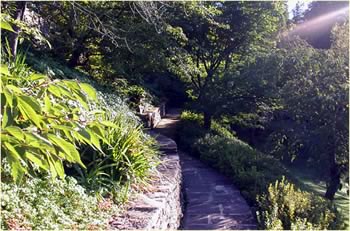Heritage Gardens
The conservation of heritage gardens poses special problems due to the rate of change in the constituent parts. This means that particular care needs to be taken in establishing what is required to be protected and/or needs to be removed to promote life and permit change. Issues will vary from garden to garden. Some gardens will contain trees and plants which are examples of highly specialised and/or rare species which must be conserved. Others will have specific trees which are valued because of their historic significance, age or appearance.
Many gardens will be valued in part for the examples of built environment of a particular period or association, such as the association with Paul Sorensen and The Braes heritage garden. Obviously, buildings, walls and paths are identifiable broadly and can be maintained within the heritage guidelines. Plants, trees and outdoor rooms and vistas are more difficult. Many valued plants are annuals and many shrubs have a limited life. Here common sense and respect for the garden should dictate how and how often plants are replaced. We have seen in the past ten years how perceptions as to the value and acceptability of many garden plants have changed.
Cotoneasters and radiata pines are now environmental weeds after many years of being admired and valued. The management of outdoor rooms and of vistas in gardens also requires care. Many outdoor rooms have been established here and in Europe with plantings within those rooms of young trees. Over fifty, one hundred or two hundred years, those trees have matured and grown and now obscure the room or vista they were meant to complement. This problem arose at Vaucluse House where the Historic Houses Trust's decision to remove healthy trees of great age to preserve William Wentworth's view of Sydney Harbour was controversial but held to be appropriate (Conservation Plan, JS Kerr, 2000, The National Trust of Australia).
At the Palace of Versailles, the destruction in a storm in December 1999 of many fine, ancient trees in the gardens was later held to be to the advantage of the gardens as a whole as the removal of the trees revealed the outdoor rooms envisaged by the original design, 350 years ago (Smithsonian Journeys, Issue July 2001). Governments are posed with a dilemma in supporting or requiring the preservation of the remains of the past. This is particularly so in regard to the preservation of heritage gardens. If the regulation of the management of a garden is undertaken too stringently, it can mean that it is not feasible, emotionally or financially, for a private person to continue to own the property.
Public bodies also do not have the funds to undertake maintenance to the levels of some of the standards imposed. (See quality of National Park Management adjacent to the Braes) Some may argue that from the archaeological point of view, it is better that no maintenance be undertaken rather than maintenance not complying with a rigid requirement to continue to replicate exactly the species, size, colour and pruning patterns of the existing garden. This, of course, poses the question of the existence of buildings and gardens as part of the continuum of life.
Distinguished French architect, Philippe Robert, has espoused the construct of "adaptive re-use" in much-admired designs for the preservation of ancient buildings in Paris. He argues that it is better that old sites be preserved using respectful adaptation as a way of financing their survival. It is clear that the principle of adaptive re-use has direct application to the conservation of heritage gardens. It is suggested that as time passes, more Australian government organisations will adopt these principles rather than be charged with setting the scene for the decay and destruction by neglect of many of the notable heritage gardens of the country.
The early classification of heritage garden significance should also be more carefully reviewed using modern technology with historic visual records in order to ensure equitable management of our nation's heritage. While Government bodies sponsor research and/or confirmation of past heritage classification by notable and authoritative academics and professionals, their support resources are often recently qualified contractors under time pressure to provide answers with limited resources and prepare reports with indirect supervision reflecting partially complete documentation which often forms the basis of the heritage classification and continuing administration.
While cost and time pressures lead to these outcomes, there is little consideration of private individuals who are the temporary custodians of buildings, gardens and other assets so classified. The Braes was one of three Sorensen gardens in Leura noted for their heritage value in the first heritage study of the Blue Mountains commissioned by the Blue Mountains City Council in the early 1980s.
The other two gardens so identified were the National Trust's Everglades and Sorensen's Nursery which remains in private ownership. While some recent articles question the involvement of Sorensen in the design of Everglades (Tanner et al), historic photographic analysis of Council's records reveal significant differences in both the scale and complexity of the garden development at Everglades compared to The Braes (1947).

Restored eastern terrace walls and pathways – late 1990s